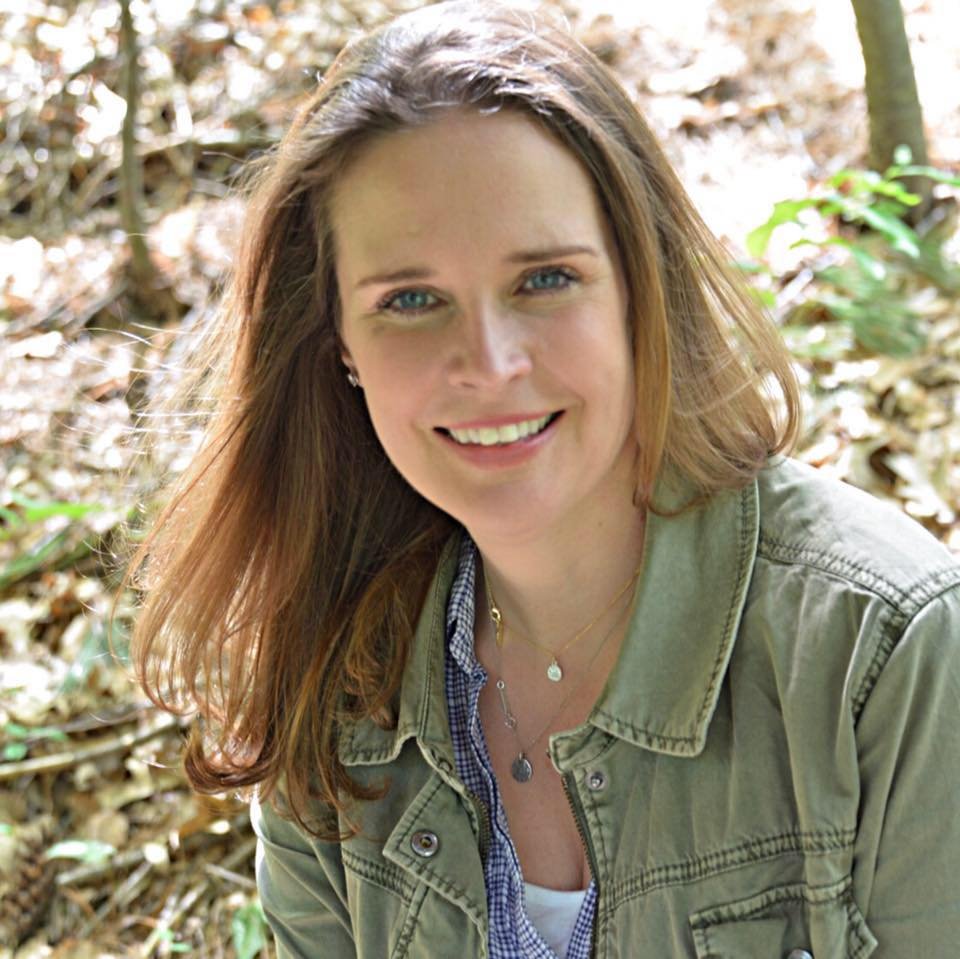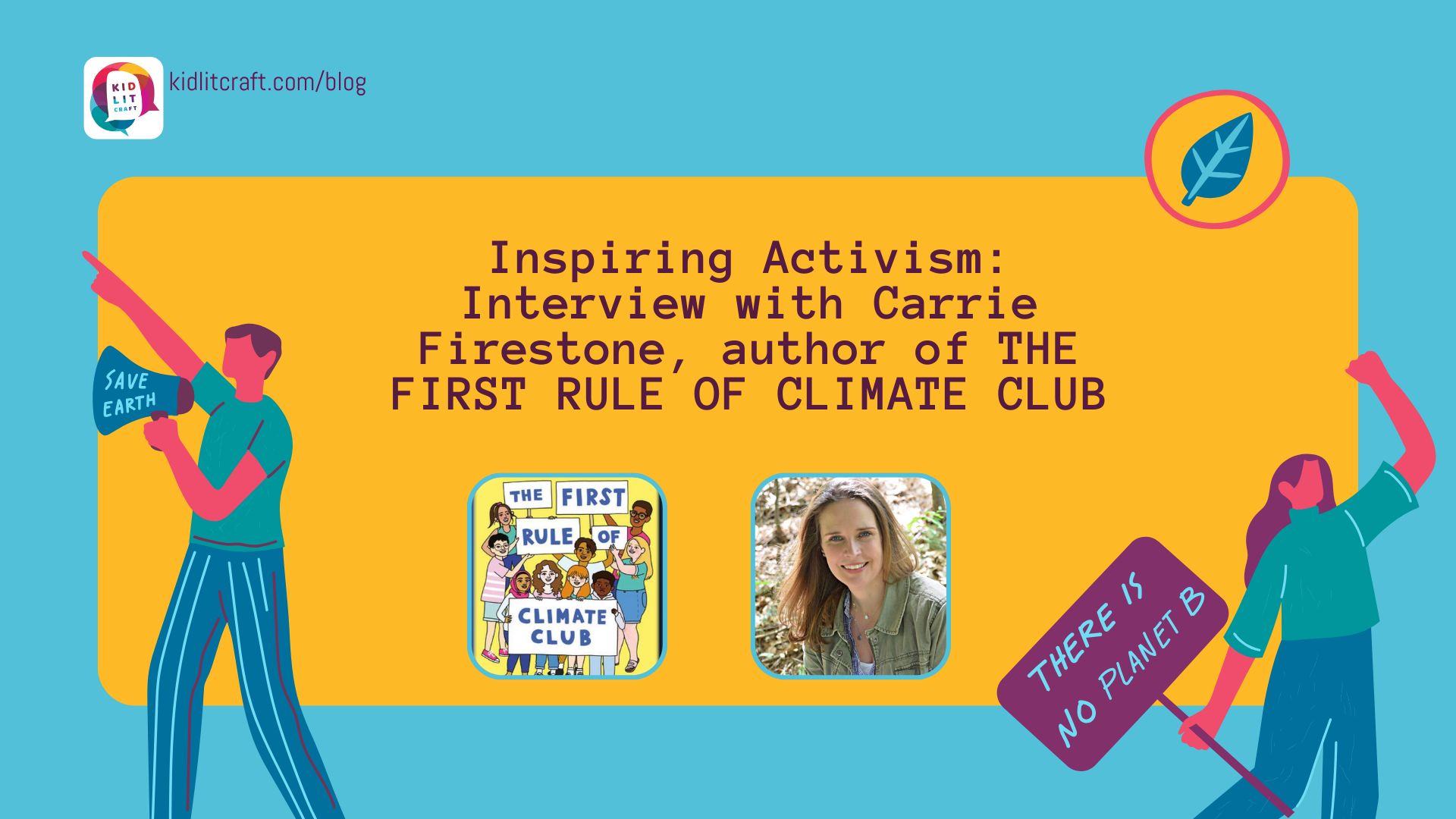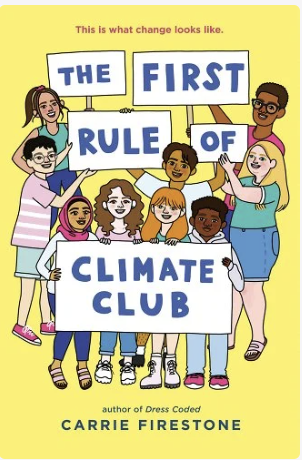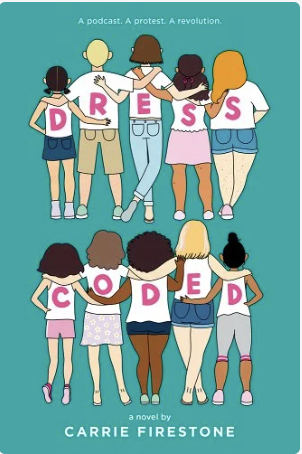interview by Cathy Petter
I first met Carrie Firestone at a writing retreat in 2016. In the following weeks I watched with admiration as Carrie jumped in to help organize her Connecticut community, raising money and sponsoring Puerto Rican families who were suffering after Hurricane Maria, organizing clothing drives for local families in need, and co-founding Forward CT, a grassroots organization dedicated to helping people and helping people be active politically. Carrie makes it easy for others to jump in and participate – and so they do. As if that weren’t enough, I’m in awe of Carrie’s writing craft. I was excited to have the opportunity to talk to her about how she combines her active writing life with her active social justice life. –Cathy Petter
KidLit Craft: What inspired you to write The First Rule of Climate Club?
Carrie Firestone: After the first book in this series, Dress Coded came out, my editor was ready for my second middle grade book. I thought yes! Now I can do my climate book.
I’ve been a climate activist since I learned about Greenpeace when I was growing up. I created a climate club when I taught high school in New York City in the 1990s. We focused on recycling, educating people about the impact of trash, organizing clean ups in the park, talking about community healing. Now the issues have only gotten bigger.
I also wanted to write about the other thing that has been a part of my young adult and then my adult life: problem-solving through community building.
KidLit Craft: I love the combination of media you use to tell the story in this book: traditional first person POV chapters, text messages, the student application essays for the climate class, among others. Why did you choose this way of telling the story? Did any of it make the writing process easier? Were there any forms that were especially challenging, that you kicked yourself later for choosing?
Carrie Firestone: I had already used this format in Dress Coded, so it became the way to tell the story in The First Rule of Climate Club. The lists were a natural for me – I love lists in my life and they are how I manage events in my life. Making them part of the book was easy and fun. I hoped that they would also help my readers understand what goes into creating a big event, and give them a structure for how to break it down into manageable pieces. I loved writing the journal entries, and I think they work really well.
After the first draft was finished, I had this huge cast of characters, and I realized that it might be hard for my readers to keep them straight. Then it hit me that I could add each person’s application essay to the climate class, and that those essays, sprinkled through the book, would help introduce each character to my readers.
The podcast format, which worked so well in Dress Coded, just didn’t feel organic in this story. It was much harder to get the podcasts to work, so I wound up cutting them back, and finding other ways to tell the story instead.
KidLit Craft: Talk to me about empowerment and engagement. It is such an important part of this story. How do you balance helping readers see what is possible with becoming too preachy?
Carrie Firestone: Everything that is in this book is something I’ve done in some capacity in my life, even the festival. Our festival was almost the same as the one that I mapped out in the book. So the suggestions are all things that I’ve done, they’re all possible, doable. I want kids to understand how much agency they have to do remarkable things.
KidLit Craft: The First Rule of Climate Club is actually a sequel. You first published Dress Coded. Can you tell us a little bit about that book and what inspired you to write it?
Carrie Firestone: Several years ago, I started a project in my hometown to investigate a gun company that had been dumping toxic waste for over a century. This was long before social media trolling became a thing – and I was shocked at the response I got. Trolls were targeting my appearance, commenting on photos of me on social media. At a certain point I realized that the reason the trolls were focusing on my appearance was because they thought they could humiliate me into stopping. It was a way to intimidate me. That experience helped me understand what teens go through every day in the age of social media.
Dress Coded was inspired by an interaction I had at my kids’ school. The dress code targeted girls, not boys, and I didn’t agree with the way the dress codes made the girls feel bad about themselves. Why are we making girls responsible for boys’ feelings? Shouldn’t we be teaching boys how to manage their own feelings? I wanted to help kids get the tools they needed to support change.
And then when I was writing The First Rule of Climate Club, I wanted to show my readers a new group of eighth graders, and how they learned the tools that the first generation had shared. Now they’re moving forward to take on the climate, because that’s the thing that really matters to them. I put some of the Dress Coded characters into the second book because I wanted to show those older kids giving support, while also giving the younger kids agency.
KidLit Craft: Dress Coded got a lovely review in The New York Times when it was published. This quote would have made me feel especially good as an author: “To young teenagers in 2020, this book is a much-needed reminder that certain fights are worth fighting, that while bears of all types may prowl unsettlingly close, fear can be faced down and victories achieved, especially with strength in numbers.” Can you talk about what it is like to get reviewed in The Times? Did you know they were going to review the book? What was the impact of their review?
Carrie Firestone: People from all over the country reached out to me after Dress Coded. A group from Nebraska met with me on Facetime sharing their speech and telling me about their process for change at their school. A kid from Alabama did it all on her own and told me all about it. Kids have reached out, they come up to me when I visit their school, it has been amazing to see young people figuring out how to use their collective voice.
I’m just starting to see it with Climate Club. I went to a school this spring and someone raised their hand to tell me that she wanted to do something more than just recycling. This is really my favorite part of this work.
The school administration in Dress Coded is the worst. Because of what’s happened, at the beginning of Climate Club, the school has a brand new team, with new ideas. I’m also hoping that teachers and staff who read Climate Club will see how different things can be when you have a supportive administration.
KidLit Craft: Can you tell me about your path to publication? Your first two novels were young adult stories. Can you talk about the difference between writing middle grade and young adult novels? What other things do you like to write?
Carrie Firestone: My books are all an extension of the activism and community organizing in my life. My teaching was also a reflection of that. I take on political/social realities that I would like to see in the world. My first book, a young adult novel, came out of my high school journals, so it had that high school voice. Dress Coded and Climate Club were written at a time when I had kids in middle school, so I had all those tween and young teenage voices all around me. Now I’m working on a new young adult novel that takes on the college admissions process.
KidLit Craft: We first met the weekend before the 2016 election, and we were both very concerned about what might happen. Since then I’ve followed your public work with admiration and interest. Can you talk a little bit about your activism, both before and after that election, and how your social and political life feeds into your artistic life?
Carrie Firestone: Prior to 2016, I had been involved in various non-profit and environmental/education-based initiatives. The day after the 2016 election, my friend (and yours) Eleni Kavros DeGraw and I realized the world was about to turn upside down. We reached out to our networks and invited people to my house the following week to figure out a local activism plan. A hundred and fifty people showed up. Since then, our grassroots organization, ForwardCT, has raised tens of thousands of dollars for local families in crisis; we’ve hosted forums, festivals, and numerous other events; and we’ve worked to get women elected at every level of government. I’m currently the Chair of my town’s Clean Energy Commission and my co-founder Eleni is our State Representative. Our entire social life is anchored in our work and my books tend to sprout up from real-life experience with successful (and not successful) grassroots initiatives.
KidLit Craft: What do you dream of doing artistically in the future? Where do you hope you’ll be, ten years from now?
Carrie Firestone: I am drawn to history, specifically the untold history of the Progressive women of the 1910’s and how they navigated adversity to champion monumental leaps in society. I’d like to write about these women. I’m also working on a plan that connects environmental writers with educators, community organizers, librarians, and readers in a streamlined way that starts meaningful conversations and, ideally, sparks action. In ten years, I hope to be finding new and exciting ways to build community, start conversations, and push hard for equity, justice, and environmental stewardship.

Carrie Firestone is an author, former high school teacher, and community builder. Her stories reflect a life-long passion for activism, travel, and bringing seemingly random groups of people together for a common cause. She currently co-runs ForwardCT, a civic engagement and service project organization in Connecticut where she lives with her husband, teen daughters, and rescue dog. Visit Carrie’s website at www.carriefirestonebooks.com
Find the author on social media:
Discover more about writing in these interviews with middle grade authors:
Cathy Petter’s debut picture book, Dear Moxie, Dear Rex, will release in the spring of 2025 from Reycraft Books. She holds an MFA in Writing for Children and Young Adults from Vermont College of Fine Arts, and is a member of SCBWI. She lives in New York City where she writes stories for kids of all ages and schemes to find cheap theater tickets. Find her on Instagram @cath.petter.




COMMENTs:
0